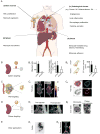Applying nanomedicine in maladaptive inflammation and angiogenesis
- PMID: 28506745
- PMCID: PMC5682240
- DOI: 10.1016/j.addr.2017.05.009
Applying nanomedicine in maladaptive inflammation and angiogenesis
Abstract
Inflammation and angiogenesis drive the development and progression of multiple devastating diseases such as atherosclerosis, cancer, rheumatoid arthritis, and inflammatory bowel disease. Though these diseases have very different phenotypic consequences, they possess several common pathophysiological features in which monocyte recruitment, macrophage polarization, and enhanced vascular permeability play critical roles. Thus, developing rational targeting strategies tailored to the different stages of the journey of monocytes, from bone marrow to local lesions, and their extravasation from the vasculature in diseased tissues will advance nanomedicine. The integration of in vivo imaging uniquely allows studying nanoparticle kinetics, accumulation, clearance, and biological activity, at levels ranging from subcellular to an entire organism, and will shed light on the fate of intravenously administered nanomedicines. We anticipate that convergence of nanomedicines, biomedical engineering, and life sciences will help to advance clinically relevant therapeutics and diagnostic agents for patients with chronic inflammatory diseases.
Keywords: Angiogenesis; Atherosclerosis; Cancer; Chronic inflammation; Immunomodulation; Macrophages; Molecular imaging; Monocytes; Nanomedicine; Targeted drug delivery.
Copyright © 2017 Elsevier B.V. All rights reserved.
Figures





Similar articles
-
Modulating angiogenesis with integrin-targeted nanomedicines.Adv Drug Deliv Rev. 2017 Sep 15;119:101-119. doi: 10.1016/j.addr.2017.05.008. Epub 2017 May 12. Adv Drug Deliv Rev. 2017. PMID: 28502767 Review.
-
Nanomedicines for dysfunctional macrophage-associated diseases.J Control Release. 2017 Feb 10;247:106-126. doi: 10.1016/j.jconrel.2016.12.032. Epub 2017 Jan 3. J Control Release. 2017. PMID: 28057522 Free PMC article. Review.
-
Nanoengineering of therapeutics for retinal vascular disease.Eur J Pharm Biopharm. 2015 Sep;95(Pt B):323-30. doi: 10.1016/j.ejpb.2015.05.001. Epub 2015 May 28. Eur J Pharm Biopharm. 2015. PMID: 26022642 Free PMC article. Review.
-
Potential role of NSAIDs loaded nano-formulations to treat inflammatory diseases.Inflammopharmacology. 2025 Mar;33(3):1189-1207. doi: 10.1007/s10787-025-01644-x. Epub 2025 Feb 14. Inflammopharmacology. 2025. PMID: 39953360 Review.
-
Targeting and therapeutic peptides in nanomedicine for atherosclerosis.Exp Biol Med (Maywood). 2016 May;241(9):891-8. doi: 10.1177/1535370216640940. Epub 2016 Mar 27. Exp Biol Med (Maywood). 2016. PMID: 27022138 Free PMC article. Review.
Cited by
-
Application of Nanomedicine in Tumor Targeting Inflammatory Pathway.Curr Med Chem. 2025;32(12):2291-2329. doi: 10.2174/0109298673277325231229093344. Curr Med Chem. 2025. PMID: 38333975 Review.
-
Sequential gastrodin release PU/n-HA composite scaffolds reprogram macrophages for improved osteogenesis and angiogenesis.Bioact Mater. 2022 Apr 1;19:24-37. doi: 10.1016/j.bioactmat.2022.03.037. eCollection 2023 Jan. Bioact Mater. 2022. PMID: 35415312 Free PMC article.
-
Antioxidant Nanotherapies for the Treatment of Inflammatory Diseases.Front Bioeng Biotechnol. 2020 Mar 18;8:200. doi: 10.3389/fbioe.2020.00200. eCollection 2020. Front Bioeng Biotechnol. 2020. PMID: 32258013 Free PMC article. Review.
-
Recent Advances in Anti-Atherosclerosis and Potential Therapeutic Targets for Nanomaterial-Derived Drug Formulations.Adv Sci (Weinh). 2023 Oct;10(29):e2302918. doi: 10.1002/advs.202302918. Epub 2023 Sep 12. Adv Sci (Weinh). 2023. PMID: 37698552 Free PMC article. Review.
-
Computational Prediction of Antiangiogenesis Synergistic Mechanisms of Total Saponins of Panax japonicus Against Rheumatoid Arthritis.Front Pharmacol. 2020 Oct 29;11:566129. doi: 10.3389/fphar.2020.566129. eCollection 2020. Front Pharmacol. 2020. PMID: 33324204 Free PMC article.
References
-
- Strong K, Mathers C, Leeder S, Beaglehole R. Preventing chronic diseases: how many lives can we save? Lancet (London, England) 2005;366:1578–1582. doi:S0140-6736(05)67341-2. - PubMed
Publication types
MeSH terms
Grants and funding
LinkOut - more resources
Full Text Sources
Other Literature Sources

